The Brazos Performance Preview: AMD E-350 Benchmarked
by Anand Lal Shimpi on November 16, 2010 12:01 AM ESTMemory and Cache Latencies
The Brazos platform was configured with 4GB of DDR3-1066 memory. The IDF system had memory running at DDR3-1333, however AMD had to decrease clocks presumably to meet validation requirements for final silicon. I measured an 86.9ns trip to main memory, a 3 cycle L1 and a ~22 cycle L2 cache. That's a lower latency memory interface than Atom or Core 2 based processors, but a higher latency L2.
CPU Performance: Better than Atom, 90% of K8 but Slower than Pentium DC
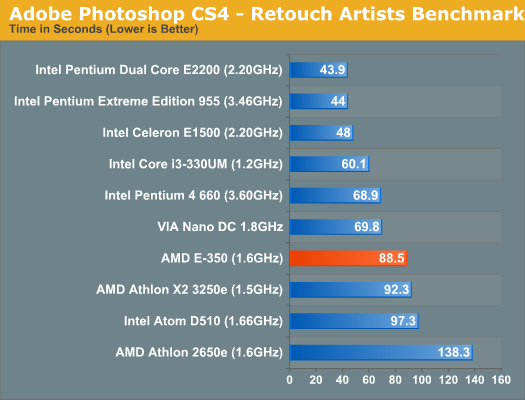
AMD's performance target for Bobcat was 90% of the performance of K8 at the same clock speed and our Photoshop CS4 benchmark shows that AMD can definitely say that it has met that goal. At 1.6GHz the E-350 manages to outperform a pair of K8s running at 1.5GHz in the Athlon X2 3250e. Unfortunately for AMD, Intel's Pentium dual-core running at 2.2GHz is much quicker. Most notebooks in the $400+ range have at least a 2.2GHz Pentium. Even the Atom D510 isn't far behind.
AMD tells me that in general purpose integer tasks, the E-350 should do well and it may even exceed AMD's 90% design target. However in higher IPC workloads, for example many floating point workloads, the E-350 is constrained by its dual issue front end. In these situations, the out of order engine is starved for instructions and much of Bobcat's advantage goes away.

Our x264 HD test has the E-350 performing within 86 - 92% of the Athlon X2 3250e, once again meeting AMD's design targets. Unfortunately, this isn't much faster than an Atom - mostly thanks to Atom's Hyper Threading support. Although not an out of order architecture, Atom gets a healthy efficiency boost by being able to execute instructions from two threads per core. Once again, compared to a 2.2GHz Pentium, the E-350 isn't close. Even VIA's dual core Nano is faster. When it comes to power consumption however, the E-350 can't be touched. I measured max system power consumption at 25.2W while running the x264 encode test. With the exception of the Atom D510, the rest of the desktop platforms here consume much more than that at idle (much less under load).
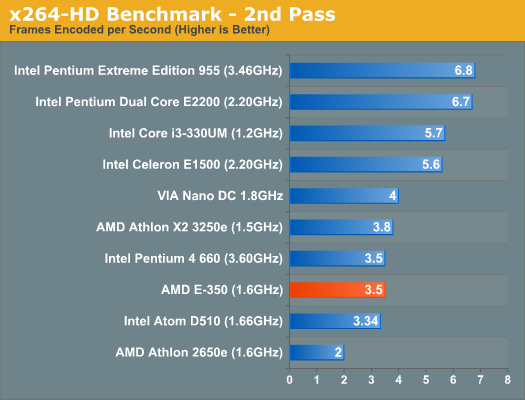
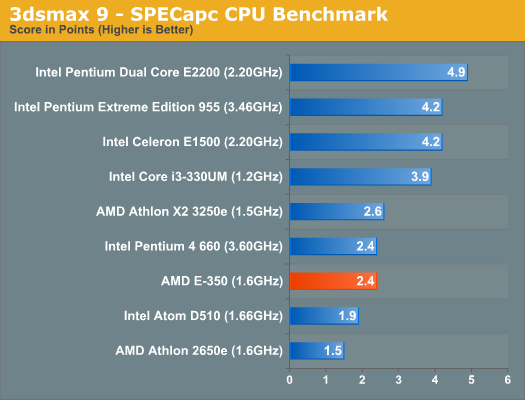
Despite being a offline 3D rendering benchmark, our 3dsmax 9 test does fall in line with expectations. The E-350 delivers 92% of the performance of the Athlon X2 3250e and outperforms the Atom D510 by 26%. Unfortunately for AMD, the Pentium dual-core holds onto a significant performance advantage here. Clock for clock, Bobcat won't be able to do much against anything Core 2 based. The real advantage here will be GPU performance.
Single Threaded Performance
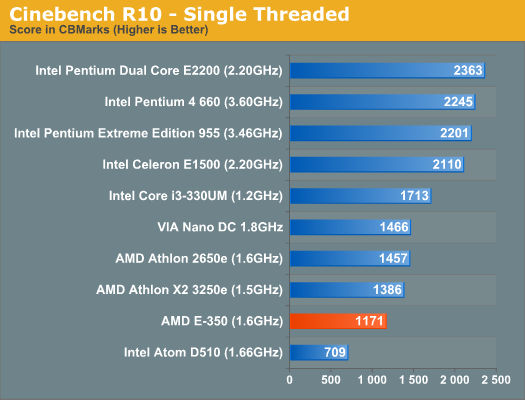
In most of our benchmarks the performance advantage over Atom isn't huge, yet using Brazos is much better than using an Atom based machine. It all boils down to one thing: single threaded performance. Atom can make up for its deficiencies by executing a lot of threads in parallel, but when you're bound by the performance of a single thread the E-350 shines. The E-350 is 65% faster than the Atom D510 in the single threaded Cinebench R10 test. It's this performance advantage that makes the E-350 feel so much quicker than Atom.
The Core i3-330UM manages a 46% performance advantage over the E-350. Even in the ultraportable Arrandale ULV space at lower clocks, AMD still leaves a lot of CPU performance on the table. The advantage here will be cost. A single E-350 is less than 40% of the die area of a Core i3-330UM. You may not get the same CPU performance, but performance per mm^2 is much higher.

In the multithreaded Cinebench test Atom is able to catch up quite a bit, but the E-350 still holds an 11% advantage.
File Compression/Archive Recovery Performance
Our final two CPU tests are both multithreaded and they show the E-350 equaling and falling behind the performance of the 1.5GHz Athlon X2. As we explained earlier, the gap between the E-350 and Atom shrinks as you add more threads to the workload.
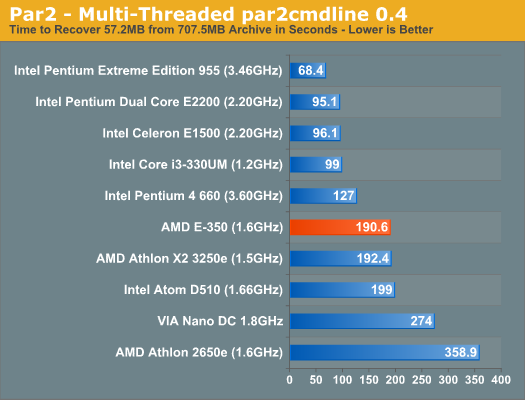
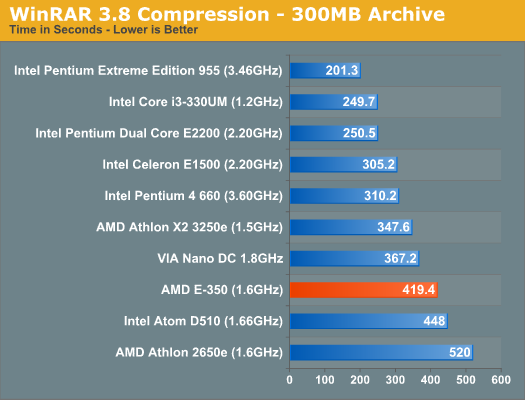










207 Comments
View All Comments
IMPL0DE - Tuesday, November 16, 2010 - link
...underwhelming. I was hopeful to see more performance out of this one. Let this not be the sign of the things to come. I still have faith in Bulldozer.Dark_Archonis - Tuesday, November 16, 2010 - link
If Bulldozer underwhelms or disappoints, AMD might be finished. I don't see how AMD could continue to be in business if two of their major new products are both underwhelming.For AMD's sake, Bulldozer needs to extremely competitive, at the very minimum.
wiak - Tuesday, November 16, 2010 - link
AMD Radeon is one line you should not underestimate ;)GeorgeH - Tuesday, November 16, 2010 - link
Bulldozer is only a piece of the puzzle. AMD's killer chip is the one that seamlessly combines what will (hopefully) be a Bulldozer core's awesome integer performance with the floating point performance of a GPU, all with competitive mobile power consumption and a process node that will allow them to make a decent profit while competing with Intel on price.Kevin G - Tuesday, November 16, 2010 - link
That will come in 2012 with the successor to Llano.The thing that AMD needs to be worried about is getting Llano out in a time frame to be competitive. It has seemingly been pushed into the middle of 2011 instead of the early 2011.
Dark_Archonis - Tuesday, November 16, 2010 - link
Great, we've been hearing that for years. First we heard that AMD's "killer product" was going to be a combination of a CPU and GPU, except they got beat by Intel on that front.Now, AMD's "killer" product apparently will be a Bulldozer CPU combined with a good GPU.
It seems that AMD's "killer" product is a continually changing target, and is something that may never arrive.
What if the competition is much stronger by the time AMD releases a Bulldozer Fusion product? What will the "killer" product for AMD be then I wonder?
Oxford Guy - Tuesday, November 16, 2010 - link
Well, years back, AMD was generally crushing Intel with its crappy NetBurst line. That may never happen again, but it was fun while it lasted. The problem for AMD is that Intel has to really screw up for it to have a chance, given Intel's leverage. An absurd design like Prescott is unlikely to come again.Dark_Archonis - Tuesday, November 16, 2010 - link
That's really the point. Even if Bulldozer is very impressive, for AMD to make financial or market share gains, Intel has to stumble. By all accounts, Sandy Bridge will be a very strong product.As I say, Intel stumbling on the scale of the P4 Netburst fiasco is unlikely to happen again. Intel is very well known in the industry for learning from their mistakes.
GeorgeH - Tuesday, November 16, 2010 - link
AMD hasn't been beaten to anything yet. CPU/GPU hybrids aren't about slapping a classical IGP together with a CPU. CPU/GPU hybrids are about combining the compute performance of a CPU with that of a GPU into a single flexible unit.Intel is moving towards that target with good CPUs and substandard GPUs. AMD is moving towards that target with substandard CPUs and good GPUs. If/when/where they meet is the point where AMD has the potential to deliver an awesome product.
Sandy Bridge, Llano, and the like are only the first few baby steps towards the goal, and it's silly to claim a "moving target" just because those steps aren't as large or as relatively impressive as we might like.
Dark_Archonis - Tuesday, November 16, 2010 - link
AMD should have never had so much hype behind Fusion in the first place then, as the product that you describe won't be on the market for several years.